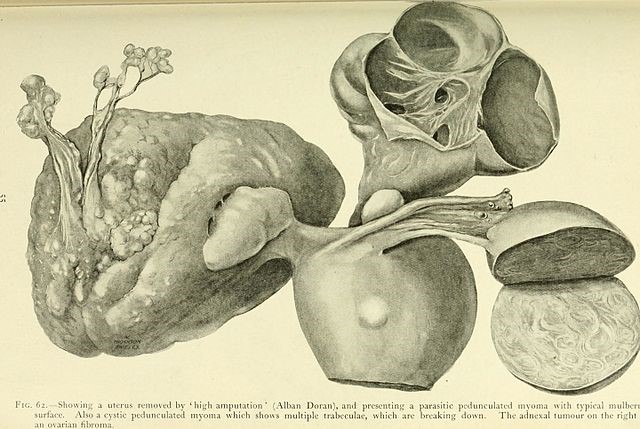What are Fibroids?
Fibroids are the non-cancerous lumps that develop abnormally and rarely, mostly in the walls of the uterus. They can grow on the skin or in the lower parts of the intestines (colon) too.[i] But the word “fibroid” is used to describe the benign fibrous tissue and muscle mass growing in or on the uterus, and we will be doing just that.
Fibroids account for about 3% of female infertility. But they only make pregnancy difficult, not impossible.
Only about 1 in 1000 cases of fibroids may be cancerous. They are classified differently (as Leiomyoma)[ii] and we will not be dealing with them now.
The formation and growth of fibroid tissue are completely dependent on the female hormones associated with fertility, estrogen, and progesterone. So, the chance of getting fibroids is limited to the reproductive years (i.e., from the first period to the last).
Fibroid Symptoms:
Most Fibroids can be asymptomatic and, of course, benign. But the following symptoms can say that you need to see the doctor. We’ll be dealing with what symptoms suggest the absolute need for medical diagnosis, and what all combinations.
– Excessive and unusual menstrual bleeding: If your periods suddenly get heavier or bleeding persists for more than 7 days, you should go see the doctor about it. Now even though you are not new to heavy bleeding, you should make an appointment if you have any of the other symptoms listed.
– Irregular Periods: Hormonal imbalance can cause both irregular menstruation and fibroids. Both hormonal imbalances and fibroids can cause irregular periods too. It’s too vicious a circle.
– Pain/pressure/bulging in the pelvic region: Unbearable/unusual pain in the lower abdomen can be a sign of fibroids, but not when without other symptoms. But pelvic bulges and feeling of pressure is usually a red flag. Bloating too is common.
– Frequent urination and trouble emptying the bladder: Although this is far from a sure shot sign, if there are other associated symptoms, then yes – to the doctor.
– Pain and distress of the lower back or legs: Again, not a telltale sign, but yes, can be associated with fibroids.
– Weight gain: As hormonal as they are, fibroids can cause weight gain, unnecessary fat deposits, and major weight fluctuations.
– Constipation and pain in the front of the lower abdomen while (somehow) passing bowels.
– Difficulty in getting and/or staying pregnant: Infertility and unreasonable/repeated miscarriages can be rooted back to both major and minor fibroids. In case your pregnancy plan is not working out for no reason, you should definitely watch out for other symptoms and consult your ob-gyn regardless.
– Painful Sex: Pain, aches, throbbing, or burning sensations can happen during and after sexual intercourse for many reasons. Fibroids can be a reason too. In any case, you can talk to your doctor regarding your trouble.
A fibroid can sometimes cause severe pain when it becomes too big for the possible blood supply; but this is usually a sign that the cells in the tissue are dying. [iii]
The different Types of Fibroids:
Uterine Fibroids are classified based on where it is formed in or on the uterus. [iv] [v] The symptoms can vary slightly with the location, and so can diagnosis. But the treatment can be quite different for each type because it depends on everything from the risk factors to method of surgery (if necessary) to recovery factors. The different types of uterine fibroids are:
(i) Intramural fibroids: They are formed inside the hollow of the uterus. They start out as small bumps/nodules inside the uterine walls and can grow in size and at a rate depending on the size of the uterus itself. They can even stretch out the uterus walls. The small ones usually don’t cause any symptoms to appear.
(ii) Submucosal fibroids: These growths are situated in the middle layer of the uterus (the muscular myometrium) but grow/extend slightly into the inner walls (endometrium) too. This is the most commonly occurring type of fibroid, can cause infertility. Even surgical procedures that remove these lumps may reduce the chance of pregnancy.
(iii) Subserosal fibroids: The fibroids that develop on the outer walls of the uterus are called subserosal fibroids. They can grow as much as the abdominal space allows and can make the belly look larger and out of shape.
(iv) Pedunculated fibroids: When the subserosal fibroids form at the end of a protruding stem-like structure on the outside of the womb, it is termed a pedunculated fibroid.
Diagnosis and Treatment of Fibroids:
Fibroid tumors are diagnosed by tests like Ultrasound, Pelvic MRI, Hysterosonography, Hysterosalpingography, or/and Hysteroscopy [vi]. In most cases, the growth of the fibroid is observed before deciding what degree of treatment is required.
Conventional surgery is one of the most common methods of removing fibroids, although there are less invasive [vii] and non-invasive techniques. [viii] Hormonal therapy, Uterine Artery Embolization, Radiofrequency Ablation, and medications like GnRH are available treatment options.
A woman with fibroids can only benefit from healthy weight loss. Home remedies and alternative medical approaches are also widespread these days, but lack enough foundation, to date.
The Controversy – Fibroids and Pesticides:
About a decade or two ago, mankind had already begun suspecting chemical components in drinking water, various food products, medications, health care products, beauty products, animal feed, hygiene products, and such other factors for causing fibroids and cancers, and tumors in general. The organic-food revolution [ix] that is steadily growing today may have been contributed by this suspicion.
These chemicals can either be directly tumor-causing or are capable of disrupting hormonal balance (endocrine-disrupting [x]), [xi] making your body develop tumors, cancers, PCOS, and fibroids.
The sources of chemicals we discussed before may also contain Xenoestrogens, or chemical byproducts that mimic estrogens, which could be even more harmful[xii].
Traces of pesticides and such chemicals are found in even human breast-milk[xiii]. In light of the fact, we can deduce (with nothing but alarm) how deep they can penetrate our body. A woman’s body usually tries to keep a baby out of harm in whichever way possible. In that case, we can also assume that the human body can in no way handle pesticides and similar chemicals well.
But the buzzing, industrialized world is too unfortunately busy to notice.
Bibliography:
1. The Nurse Practitioner, 2005. Nonsurgical Uterine Fibroid Treatment. 30(1), p.62.
2. Patricia Evans, Susan Brunsell, 2007. Uterine Fibroid Tumors: Diagnosis and Treatment. Am Fam Physician. 75(10):1503-1508.
[ii] https://en.wikipedia.org/wiki/Leiomyoma
[iii] Uterine fibroids – Symptoms and causes – Mayo Clinic
[iv] Fibroids: Types, Causes, and Symptoms (healthline.com)
[v] Fibroids: Causes, symptoms, treatment, and types (medicalnewstoday.com)
[vi] Uterine fibroids – Diagnosis and treatment – Mayo Clinic
[vii] Wang Y, Zhang S, Li C, Li B, Ouyang L. Minimally invasive surgery for uterine fibroids. Ginekol Pol. 2020;91(3):149-157.
[viii] https://www.nwh.org/womens-health-center/center-for-minimally-invasive-gynecologic-surgery/fibroids
[ix] Nicolopoulou-Stamati, P., Maipas, S., Kotampasi, C., Stamatis, P., & Hens, L. (2016). Chemical Pesticides and Human Health: The Urgent Need for a New Concept in Agriculture. Frontiers in public health, 4, 148. https://doi.org/10.3389/fpubh.2016.00148
[x] ScienceDaily. 2021. Chemical exposure linked to 1.4 billion euros in women’s health care costs, study suggests: Endocrine-disrupting chemicals may raise risk of developing endometriosis, uterine fibroids. [online] Available at: <https://www.sciencedaily.com/releases/2016/03/160322133810.htm> [Accessed 1 March 2021].
[xi] Katz, T., Yang, Q., Treviño, L., Walker, C. and Al-Hendy, A., 2016. Endocrine-disrupting chemicals and uterine fibroids. Fertility and Sterility, 106(4), pp.967-977.
[xii] Fibroid101.com. 2021. Xenoestrogens Cause Uterine Fibroid Tumor ( Myoma ). [online] Available at: <https://fibroid101.com/xeno.htm> [Accessed 28 February 2021].
[xiii] Nicolopoulou-Stamati, P., Maipas, S., Kotampasi, C., Stamatis, P. and Hens, L., 2016. Chemical Pesticides and Human Health: The Urgent Need for a New Concept in Agriculture. Frontiers in Public Health, 4.

